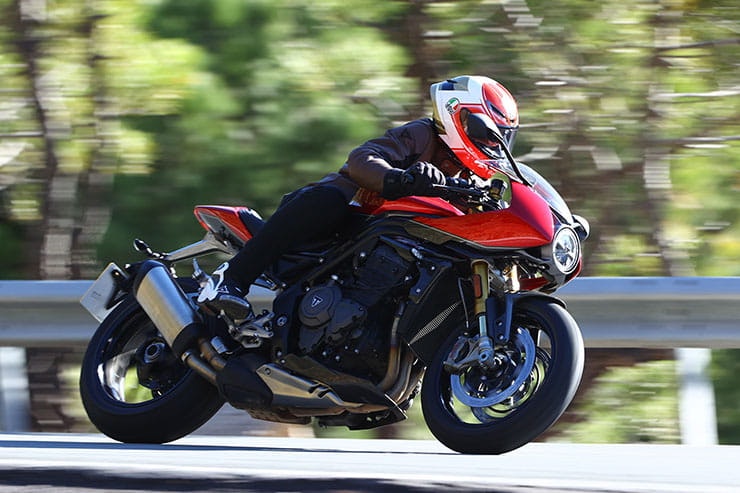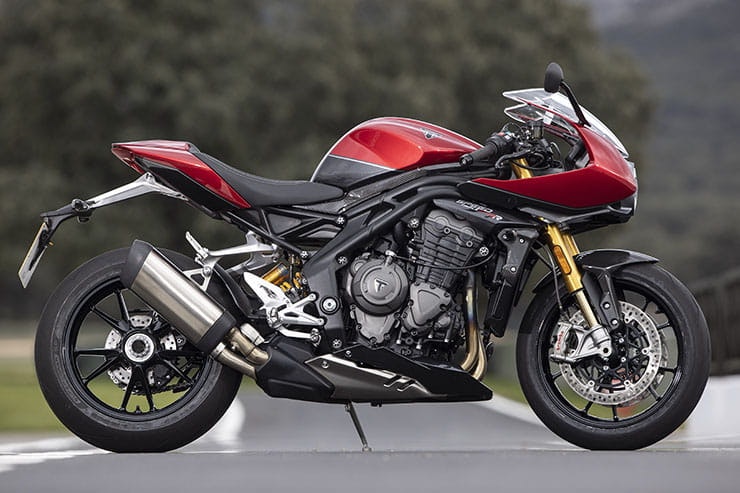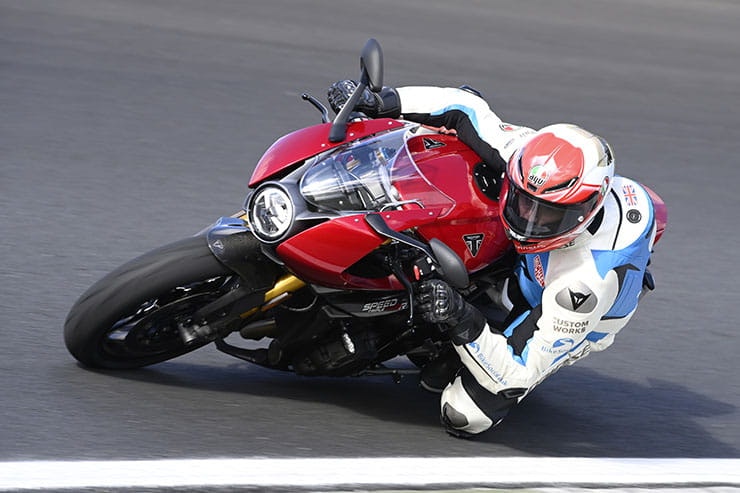Triumph Speed Triple 1200 RR (2022) - Review
By Michael Mann
BikeSocial Managing Editor
30.11.2021
Helmet
Road/Track - AGV Pista GP-RR (with custom paint from LDC Designs), £999.99 | www.agv.co.uk
Jacket
Road - Dainese Razon 2, £369.95 | www.dainese.com
Track - Dainese Mugello RR D-air, £3399.95 | www.dainese.com
(with Dainese Custom Works design and fitting)
Trousers
Road - Dainese Chinos Tex Pants, £249.95 | www.dainese.com
Track - Dainese Mugello RR D-air, £3399.95 | www.dainese.com
(with Dainese Custom Works design and fitting)
Boots
Road/Track - Dainese Axial D1, £549.95 | www.dainese.com
Gloves
Dainese Druid 3, £199.95 | www.dainese.com
Triumph’s venture towards offering a fully armed supernaked to compete with the big guns from Aprilia, Ducati, BMW, et al. gained dramatic momentum earlier this year with the reveal of the Speed Triple 1200 RS back in April. The 2021 model showed up with a raft of alterations to its predecessors with power, performance and tech as its stand-out upgrades, and almost 4,000 have been sold since. Roll on 6 months and here we have the Triumph Speed Triple 1200 RR – a bike that was not alluded to when the RS appeared in dealerships yet is heavily based on the naked machine and was clearly conceived on the same piece of designer’s paper.
New were the 3-cylinder 1160cc engine, chassis, suspension, plenty of rider aids, a colour TFT dash and more of a sporty focus. 30bhp more peak power with 10kg less weight than the predecessor is an ideal combination to demonstrate development. And here we are with the RR version taking the RS and adding that lovely half-fairing, clip-ons, swapping Metzeler for Pirelli, a revised riding position and some top-spec semi-active and electronically adjustable Öhlins suspension. The fairing, according to social media comments, is a little bit marmite with lovers and haters in equal measure. Up close, it’s easy to spot the attention to detail in the bespoke design although the single headlight does trample on the Speed Triple’s DNA somewhat.
Can it serve an undiscovered audience who crave the sporty performance and fairing yet don’t need the origami-like riding position and resulting chiropractor appointments?
BikeSocial’s Michael Mann was in the South of Spain for a day on the roads around Ronda before a handful of track sessions at the Ascari circuit.
Grown-up looks
Plush suspension and its array of settings
A perfect compromise for sporty road riding
Clutch cable across the TFT screen
£250 on top of £18k for a different colour? Come on
A missing naughty streak. It’s almost too civilised.
Triumph Speed Triple 1200 RR (2022) - review
The 2022 Triumph Speed Triple 1200 RR was conceived at the same time as the RS and shares many components except the sexy half-fairing, clip-ons and fancy Öhlins electronic suspension. Join BikeSocial’s Mann as he spends a day on road and track in Spain.
Triumph Speed Triple 1200 RR Price
How much is the 2022 Triumph Speed Triple 1200 RR? £17,950 for the Crystal White/Storm Grey version, while the other colour option known as Red Hopper/Storm Grey version will add a further £250
Speaking of £250, that’s what you could be paying per month for a Speed Triple 1200 RR spread over 3-years after a 10% deposit, according to the representative PCP example on Triumph’s website, which looks like this:
Power and torque
Because the 1160cc, 3-cylinder, liquid-cooled engine is identical to that in the naked RS, as is the gearbox, it pumps out the same peak performance and torque figures of 177.6bhp (132.4kW) @ 10,750rpm and 125Nm (92.2ftlb) @ 9000rpm.
On the road and the mid-range boot and broad spread of drive, from third gear in particular, are enough to combat the sweeping, cascading turns of the Ronda road plus the ability to overtake the plethora of motorhomes. In fact, such are its manners the RR doesn’t even sound racy until 5-6000 rpm so you can breeze by the slower traffic without upsetting them. The only place an extra 30-or-so bhp would have been handy is the track. And it’s too pretty for the track.
Engine, gearbox, and exhaust
Revel in its flexibility because the three-cylinder 1160cc, liquid-cooled mechanism has plenty of range. You’ll find enough oomph for a quick getaway from as little as 4000rpm but you only have to patient for a second because a bow wave of power comes flooding in at 6000rpm lasting all the way beyond 10k. But hold on. The RR is surely too cultured to have its neck wrung, this upstanding gentleman of a motorcycle shouldn’t be fought with, it looks like it needs treating with respect. So, while it will do the sporty stuff well should you wish to drop a couple of gears, tear the throttle back and get yourself tucked in, the RR will soon thunder along, and it remains a very good compromise between the more hostile 200bhp+ machinery, with or without fairing.
It feels like it hasn’t lost any of that 1050 character which made the previous generation Speed so popular, particularly towards the mid-top end with the 1200’s increase in revs and power, so the character has moved a little. The way the torque keeps coming in a linear manner is more than useful, and for the endless semi-open corners of the Ronda road, I’m glad third gear is so extensive too. It’s an easy engine to get along with, there’s little hostility, it’s friendly, eager and will reward you if you aim towards the mid-range. Plus it’s smooth to operate with a lovely throttle connection and lightweight slip and assist clutch. That said, and I only really found this on the track section of the launch, but the slight hesitation between off and on throttle mid-corner resulted in a minimal snatchy feel. Then again, and I’m very aware I’m repeating myself, the RR is more at home on the road than out-and-out track attack.
Overtaking is a doddle. And you’ll want to keep overtaking to suck more of the triple’s tone into your ears (if you actually suck into your ears), it could have done with a larger air intake for added performance and noise considering its sportier nature. The engine, thanks to the narrow stacked gearbox, is a slender thing, snug inside this aluminium twin spar frame which aids the athleticism of the RR and encourages the rider to make the most of the performance from this 1160cc engine that has the dimensions of an older supersport.
The standard-fit up-and-down quickshifter is a joy. A slight input from your left boot and a short throw of the lever has you in the next gear before you can blink. It’s sharp, fast and doesn’t affect the pitch of the bike one bit. A couple of others on the launch found neutral when coming down from 2nd to 1st but I had no such issue.
We were told on the RS press briefing about the big upswept silencer being optimised for performance which is the reason why an accessory fit aftermarket option wasn’t available, which is a shame. For all the Triumph put into hiding the exhaust run with a neat lower fairing, I think the twin inputs seem a little clumsy.
Handling, suspension, and weight
Adding streamline fairings, racier rubber and top-draw Öhlins to an already highly capable road bike is a recipe for a sharp-handling and sportier machine, obviously. Bring the pegs higher and move the bars further away/lower and the compromise between a nervous handling naked and an all-out track weapon has certainly been found to really make the most out of the engine and chassis.
Handling-wise, the RR is more than adept at taking anything we offered it on the streets of Southern Spain, though the rougher B roads of the UK will prove more of a challenge. That, however, shouldn’t be an issue given the superb suspension upgrade because the semi-active, electronically adjustable Öhlins S-EC 2.0 OBTi system provides a system that makes the best of both worlds. Adjusting compression and rebound damping while riding means there’s no end of calculations occurring below you with optimisation for acceleration, cornering or braking support, offering more compliance on a bumpy road and an overall better riding experience. Pre-set suspension settings are built into each rider mode though they can be manually adjusted by the rider via the dashboard instead of the old clickers. It’s a brilliantly complex system than can be operated so easily. After all, suspension settings are a dark art that can make or break your riding pleasure – on the RR it’s all in hand. I could rattle on for ages about the complexities of the suspension but pick your mode and let it do all the work for you. Then, when you’re home and nothing aches you can be happy that a large portion of the price tag is justifiable.
The riding position isn’t as extreme as you might expect given the peg and bar repositioning. You don’t end up feeling too folded up yet there’s still a slight annoyance from my 6-foot frame on the position of the inside of my knee against the frame. I soon got over it but if you’ve got long legs then do check it if test-riding. The fairing is stylish, offers a neat silhouette and is café-racer style low. When tucked in on the fast straight bits, it can be slightly imposing with its proximity to your visor. I’d love to have seen the architect’s drawing board if they’d attempted a fairing using the twin lights of the RS!
Pirelli Diablo Supercorsa SP’s bring an extra element of track-readiness to the Triumph, replacing the Metzeler’s on the RS. Any early concerns about the 3-degree air temperature when we set off on the road ride being way outside the tyres usual operating window were soon eliminated because the surface of the Ronda road worked in the Pirelli’s favour. Triumph hasn’t done things by halves here – the high spec suspension, tyre and brakes collaboration isn’t unique but is usually reserved for the more premium, track-focused machines. And it’s part of the reason why the RR has such a high price. Remember that it is a slightly compromised machine though, it’s not an out-and-out track bike, and even if you’re among the 0.1% of owners who might consider taking this on the circuit then unless your name is Marquez it will still impress. Keep the bike in the mid-range, which might involve short-shifting up, and that’s where the engine will still excite.
Triumph Speed Triple 1200 RR (2022) Comfort and economy
The adjustments made to the riding position from the naked RS version see the handlebars 135mm lower and 50mm further forward while the footpegs are 15mm higher and 26mm further back, all equating to… you’ve guessed it, a sportier riding position hence the fairing and RR moniker. The positional differences certainly accentuate the weight into the wrists element though the low height of the screen tricks you into thinking you’re not fully tucked. The airflow up and over the fairing offers a degree of additional comfort from wind blast, and of course it’s far more than a naked would.
On the road section of our test ride, we covered 70 miles and the economy was just 34mpg which is fair way off the claimed 44.8mpg though a press launch isn’t often a fair reflection on an accurate economy. So the 15.5 litre tank should take you somewhere between 115 – 150 miles depending on how and where you ride.
Brakes
Brembo’s latest Stylema monobloc callipers grip a twin set of 320mm disc at the front while a single 220mm version adorns the rear wheel – it’s like a fashion statement to be seen with the latest must-haves, but unlike wearing short trousers without socks, these Brembo’s could save your life. They’re linked, have their own master cylinders and are boosted by some clever Cornering ABS too. On the road and the engine braking and slightest pull on the lever is all I need to shave a little speed or haul me to a stop and so the top-spec stoppers seem a little too much. They have a decent feel and when the electronic suspension is working on your team too, the bike remained unflappable.
On the track added speed affects your reliance and confidence on the brakes which felt comfortable working in unison with the electronic brains of the bike plus the Öhlins, all offering stability while trail braking in the faster corners – the third gear Senna left-hander, for example. In a straight line and using extra force to scrub more speed off for a slower turn, and there was a missing something in terms of feel which ended up pushing the front wide. It’s negligible and certainly not an issue with road use.
Rider aids, extra equipment, and accessories
The smart, neat and well-packaged 5” TFT screen sits snugly under the fairing and was clear to see in all conditions experienced on the launch ride. Options to change the display colour and layout are a recognisable trait of modern-day Triumphs as is the small 5-way joystick on the left-hand ‘bar. A rider mode ‘M’ button, ‘Home’ button and Cruise Control switch also link to the dash which is clear, the font is readable, and the operations are quick. The four pre-set rider modes and further rider configurable mode can be altered on the fly with a tap of the button and a quick close of the throttle, and as you’d expect the throttle response, engine braking, traction and abs setting plus pre-defined electronic suspension settings are all altered with each mode. There’s a notable difference between Road and Sport with the firmness of the suspension that encourages a more focused riding style as you start to explore the grip from the front Pirelli.
It wouldn’t be a Triumph without a stack of accessories, and thirty of them are available in categories including protection, security, luggage and styling. I was grateful for the optional heated grips fitted to the test bikes given the unseasonably near-freezing conditions around Ronda. A bi-directional quickshifter also comes as standard.
Rivals
To classify the RR among close competitors is a tough one because Triumph has almost invented its own category of Road-Sport or even Retro Racer for sanitised superbikes.
Here’s a high-level comparison chart with the 2021 Aprilia Tuono V4 1100 (not the Factory version) leading the way because of its half-fairing, screen and performance providing strong similarities to the RR. It weighs 10kg more but is around £3,000 less:
Triumph Speed Triple 1200 RR (2022) Verdict
Here is a motorcycle that sits in between the modern day supernakeds packed full of their power, electronics and attitude yet little weather protection or practicality, and the more established superbikes with their 200bhp+ and sporty credentials yet high pegs, low bars and overall discomfort. The more appealing riding position of the RR paired with performance to get your endorphins quickstepping, the impressive electronics suite, easily operated TFT display and rider refinements, and an overall feel-good factor, not to mention the looks, is going to be the catalyst for some big sales for Triumph. I’d suggest a comparative number as the RS sales in its first 6 months.
Triumph’s most powerful bike in its current line-up is calm and comfortable on the road with a tendency to break free from its shackles with minimal encouragement from the twisty handle. It’s not nearly as lairy as the Tuono V4 which has the most sublime throttle connection of any bike, ever, yet this RR digs in and sings its song from c.6k rpm booting it into full gallop devouring road or track with ease. It’s a more refined sprint, gliding towards the naughty speeds compared to the more raucous Aprilia, plus the British entrant looks better, and the electronics, interface and suspension are more sophisticated.
The downside to not sitting in one particular category is ambiguity. Is it too close to the RS with its identical engine performance? Should it have had 25 more bhp and some naughtier lower range grunt to make it stand clearer from the RS shoving it into the sports bike league? Perhaps it’s a stepping stone to a currently non-existent Daytona 1200, though hypothetically if that were to go on sale at exactly the same time as the RR, it’d be the latter that’d sell better given its wider market appeal. Or how about a half-fairing, café sport style 765 Street Triple RR next?
Triumph Speed Triple 1200 RR (2022) Technical Specification
Photos: Kingdom Creative (Chippy Wood / Gareth Harford)
Video: Kingdom Creative / Too Fast Media
What is MCIA Secured?
MCIA Secured gives bike buyers the chance to see just how much work a manufacturer has put into making their new investment as resistant to theft as possible.
As we all know, the more security you use, the less chance there is of your bike being stolen. In fact, based on research by Bennetts, using a disc lock makes your machine three times less likely to be stolen, while heavy duty kit can make it less likely to be stolen than a car. For reviews of the best security products, click here.
MCIA Secured gives motorcycles a rating out of five stars, based on the following being fitted to a new bike as standard:
A steering lock that meets the UNECE 62 standard
An ignition immobiliser system
A vehicle marking system
An alarm system
A vehicle tracking system with subscription
The higher the star rating, the better the security, so always ask your dealer what rating your bike has, and compare it to other machines on your shortlist.


